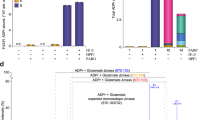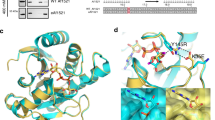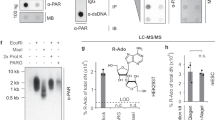Abstract
Poly(ADP-ribosyl)ation is catalyzed by a family of enzymes known as PARPs. We describe a method to characterize the human aspartic acid– and glutamic acid–ADP-ribosylated proteome. We identified 1,048 ADP-ribosylation sites on 340 proteins involved in a wide array of nuclear functions; among these were many previously unknown PARP downstream targets whose ADP-ribosylation was sensitive to PARP inhibitor treatment. We also confirmed that iniparib had a negligible effect on PARP activity in intact cells.
This is a preview of subscription content, access via your institution
Access options
Subscribe to this journal
Receive 12 print issues and online access
$259.00 per year
only $21.58 per issue
Buy this article
- Purchase on Springer Link
- Instant access to full article PDF
Prices may be subject to local taxes which are calculated during checkout



Similar content being viewed by others
Change history
26 August 2013
In the version of this article initially published online, the x-axis tick label "≥15" in Figure 3e was mislabeled. The error has been corrected for the print, PDF and HTML versions of this article.
References
Chambon, P., Weill, J.D. & Mandel, P. Biochem. Biophys. Res. Commun. 11, 39–43 (1963).
Rouleau, M., Patel, A., Hendzel, M.J., Kaufmann, S.H. & Poirier, G.G. Nat. Rev. Cancer 10, 293–301 (2010).
Krishnakumar, R. & Kraus, W.L. Mol. Cell 39, 8–24 (2010).
Wahlberg, E. et al. Nat. Biotechnol. 30, 283–288 (2012).
Farmer, H. et al. Nature 434, 917–921 (2005).
Tulin, A. Nat. Biotechnol. 29, 1078–1079 (2011).
Dani, N. et al. Proc. Natl. Acad. Sci. USA 106, 4243–4248 (2009).
Hengel, S.M. & Goodlett, D.R. Int. J. Mass Spectrom. 312, 114–121 (2012).
Hassa, P.O., Haenni, S.S., Elser, M. & Hottiger, M.O. Microbiol. Mol. Biol. Rev. 70, 789–829 (2006).
Tao, Z., Gao, P. & Liu, H.W. J. Am. Chem. Soc. 131, 14258–14260 (2009).
Liu, X.C. & Scouten, W.H. Methods Mol. Biol. 147, 119–128 (2000).
Moss, J., Yost, D.A. & Stanley, S.J. J. Biol. Chem. 258, 6466–6470 (1983).
Chapman, J.D., Gagne, J.P., Poirier, G.G. & Goodlett, D.R. J. Proteome Res. 12, 1868–1880 (2013).
Ali, A.A. et al. Nat. Struct. Mol. Biol. 19, 685–692 (2012).
Yu, Y. et al. Science 332, 1322–1326 (2011).
Zhang, Y. et al. Nat. Cell Biol. 13, 623–629 (2011).
Liu, X. et al. Clin. Cancer Res. 18, 510–523 (2012).
Patel, A.G., De Lorenzo, S.B., Flatten, K.S., Poirier, G.G. & Kaufmann, S.H. Clin. Cancer Res. 18, 1655–1662 (2012).
Langelier, M.F., Planck, J.L., Roy, S. & Pascal, J.M. Science 336, 728–732 (2012).
Oei, S.L. & Shi, Y. Biochem. Biophys. Res. Commun. 285, 27–31 (2001).
Olsen, J.V. et al. Mol. Cell. Proteomics 8, 2759–2769 (2009).
Huttlin, E.L. et al. Cell 143, 1174–1189 (2010).
Kim, W. et al. Mol. Cell 44, 325–340 (2011).
Schwartz, D. & Gygi, S.P. Nat. Biotechnol. 23, 1391–1398 (2005).
Hubbard, S.J., Campbell, S.F. & Thornton, J.M. J. Mol. Biol. 220, 507–530 (1991).
Acknowledgements
We thank S. McKnight and H. Yu for discussions. We thank H. Yu, H. Mirzaei and S. Gygi for access to the tissue culture, mass spectrometry and computation facilities, respectively. pCMV-Sport6-GAR1 and pCMV-Sport6-DDX21 were kind gifts from L. Lum (University of Texas Southwestern Medical Center). This work was supported by grants from the UT Southwestern Medical Center Endowed Scholar Program, the Cancer Prevention and Research Institute of Texas (CPRIT R1103) and the Welch Foundation (I-1800) to Y.Y. Y.Y. is a Virginia Murchison Linthicum Scholar in Medical Research and a CPRIT Scholar in Cancer Research.
Author information
Authors and Affiliations
Contributions
Y.Y. conceived the project and designed the approach. Y.Y., Y.Z. and M.D. performed research and analyzed data. Y.Y. and J.W. performed computational analyses. Y.Y. supervised the project. Y.Y. wrote the manuscript with input from all coauthors.
Corresponding author
Ethics declarations
Competing interests
A US patent on the method described in this manuscript, along with the sites identified, has been filed (no. 13/874,453 to Y.Y.).
Supplementary information
Supplementary Text and Figures
Supplementary Results and Supplementary Figures 1–6 (PDF 1382 kb)
Supplementary Table 1
Asp- and Glu-ADP-ribosylated peptides and proteins identified in shPARG HCT116 cells using 0.2 mM H2O2 stimulation. Description of the column headings is included. ## indicates the reverse hits. (XLSX 143 kb)
Supplementary Table 2
Asp- and Glu-ADP-ribosylated peptides and proteins identified in shPARG HCT116 cells using 2 mM H2O2 stimulation. (XLSX 178 kb)
Supplementary Table 3
Asp- and Glu-ADP-ribosylated peptides identified and quantified (as shown in Fig. 3a) using single Lys labeling (Lys0 and Lys8 for light and heavy, respectively). Data from the two technical replicate analyses were included. Light cells were stimulated with 2 mM H2O2 whereas heavy cells were pretreated with olaparib, then stimulated with 2 mM H2O2. Additional information about the headings (for peptide quantitation) is included. (XLSX 622 kb)
Supplementary Table 4
Asp- and Glu-ADP-ribosylated peptides identified and quantified using double labeling of Lys and Arg (Lys0/Arg0 and Lys8/Arg10 for light and heavy, respectively). Data from two technical replicate analyses were included. Light cells were stimulated with 2 mM H2O2 whereas heavy cells were pretreated with olaparib, then stimulated with 2 mM H2O2. (XLSX 391 kb)
Supplementary Table 5
Asp- and Glu-ADP-ribosylated peptides identified and quantified in response to A966492 treatment as shown in Fig. 3d. Light cells were stimulated with 2 mM H2O2 whereas heavy cells were pretreated with 1 mM A966492, then stimulated with 2 mM H2O2. (XLSX 160 kb)
Supplementary Table 6
Asp- and Glu-ADP-ribosylated peptides identified and quantified in response to AG14361 treatment as shown in Fig. 3d. Light cells were stimulated with 2 mM H2O2 whereas heavy cells were pretreated with 1 μM AG14361, then stimulated with 2 mM H2O2. (XLSX 140 kb)
Supplementary Table 7
Asp- and Glu-ADP-ribosylated peptides identified and quantified in response to iniparib treatment as shown in Fig. 3d. Light cells were stimulated with 2 mM H2O2 whereas heavy cells were pretreated with 50 μM iniparib, then stimulated with 2 mM H2O2. (XLSX 230 kb)
Supplementary Table 8
Asp- and Glu-ADP-ribosylated peptides identified and quantified in response to 3-AB treatment as shown in Fig. 3d. Light cells were stimulated with 2 mM H2O2 whereas heavy cells were pretreated with 50 μM 3-AB, then stimulated with 2 mM H2O2. (XLSX 265 kb)
Supplementary Table 9
Asp- and Glu-ADP-ribosylated peptides and proteins identified in shPARG HEK293T cells, using 2 mM H2O2 stimulation. (XLSX 134 kb)
Supplementary Table 10
Asp- and Glu-ADP-ribosylated peptides and proteins identified in shGFP HCT116 cells, using 2 mM H2O2 stimulation. (XLSX 25 kb)
Supplementary Table 11
Asp- and Glu-ADP-ribosylated peptides and proteins identified in shGFP and shPARG HCT116 cells in response to the treatment of 50 μM MNNG. (XLSX 144 kb)
Supplementary Table 12
Asp- and Glu-ADP-ribosylated peptides and proteins identified in shGFP HCT116 cells with no treatment of DNA-damaging agents. (XLSX 12 kb)
Supplementary Table 13
The complete list of the identified ADP-ribosylated sites. Modified sites (Asp and Glu) are aligned, with their ModScore (the highest score) and the number of identification shown. Also included is a tab summarizing the results of quantitative analyses of the ADP-ribosylated peptides in response to PARP inhibitor treatment, including olaparib, A966942, AG14361, iniparib and 3-AB. Only peptides with their ADP-ribosylation site(s) confidently-localized (ModScore ≥ 13) were included. For peptides that were identified multiple times, the one with the highest summed (Light+Heavy) intensity is reported. SNR, signal-to-noise ratio. (XLSX 295 kb)
Rights and permissions
About this article
Cite this article
Zhang, Y., Wang, J., Ding, M. et al. Site-specific characterization of the Asp- and Glu-ADP-ribosylated proteome. Nat Methods 10, 981–984 (2013). https://doi.org/10.1038/nmeth.2603
Received:
Accepted:
Published:
Issue Date:
DOI: https://doi.org/10.1038/nmeth.2603
This article is cited by
-
Regulation of Rad52-dependent replication fork recovery through serine ADP-ribosylation of PolD3
Nature Communications (2023)
-
Poly(ADP-ribose)-binding protein RCD1 is a plant PARylation reader regulated by Photoregulatory Protein Kinases
Communications Biology (2023)
-
Serine ADP-ribosylation in Drosophila provides insights into the evolution of reversible ADP-ribosylation signalling
Nature Communications (2023)
-
Recent advances in chromosome capture techniques unraveling 3D genome architecture in germ cells, health, and disease
Functional & Integrative Genomics (2023)
-
PARP1 and XRCC1 exhibit a reciprocal relationship in genotoxic stress response
Cell Biology and Toxicology (2023)



